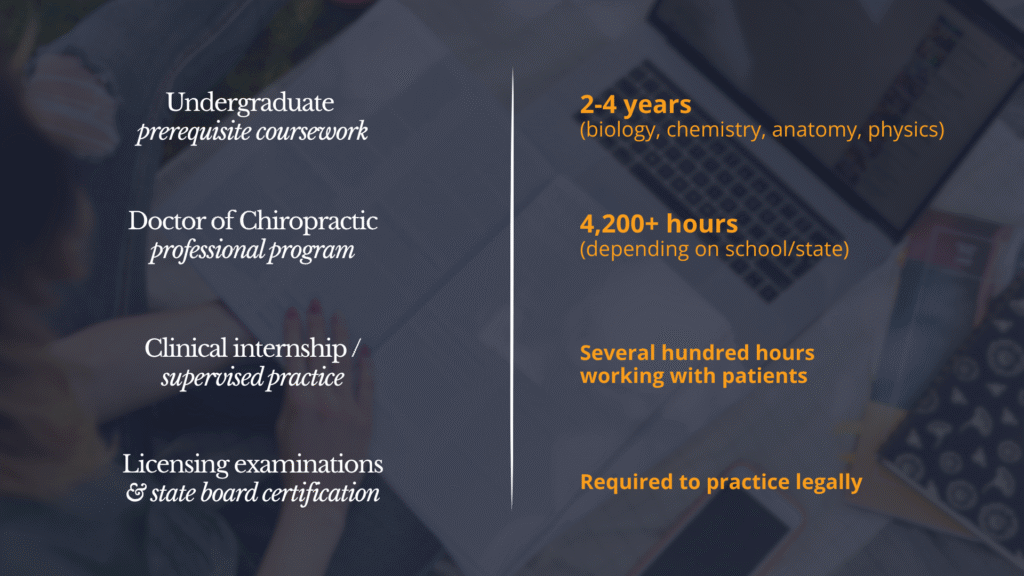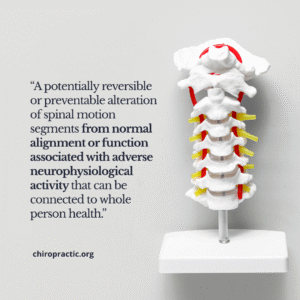If you’re seeking help, skeptical about Chiropractic care, or just exploring your options, welcome. It can be life-changing to understand how your body and nervous system truly work! Read on to learn how to release your own self-regulating, self-healing power.
Watch the brief video below to get an overview from our past president, Dr. Selina Sigafoose-Jackson, and scroll down for the full article with more details. We hope you find the information clear, uplifting, and empowering as you consider your health-care decisions.
This article answers:
- Your Nervous System & Chiropractic
- What Is a Doctor of Chiropractic?
- What Is a Chiropractic Adjustment?
- Who Is Chiropractic For – Who Can Get Adjusted?
- Common Reasons People Go to a Chiropractor & Benefits
- Chiropractic Myths Debunked
- Specialties Within Chiropractic
- How to Find a Great Chiropractor
- The ICA: Empowering Humanity to Optimal Life Expression
Your Nervous System & Chiropractic
Your body is designed to heal and function at its best; chiropractic care simply helps it do that.
At the center of your health is your nervous system, the network that controls and coordinates every part of your body. It’s protected by your spine, which also allows you to move and adapt to life’s daily stresses. When the spine becomes misaligned or restricted, it can disrupt the signal processing in the brain and alter the signals traveling between your brain and body.
Chiropractic care works to restore healthy alignment and function of the spine. This helps clear interference in the nervous system so your body can communicate, heal, and perform the way it’s meant to.
The principle is simple: when your spine and nervous system work together in harmony, your body is stronger, healthier, and more resilient. Whether you’re young or old, in pain or just aiming to stay well, chiropractic care supports your body’s natural ability to adapt and thrive.
As more people choose natural and preventive approaches to health, chiropractic care continues to grow worldwide. It’s now one of the most trusted wellness professions, ranking third among primary healthcare fields in the Western world, after medicine and dentistry, and is officially recognized in more than 68 countries.
What Is a Doctor of Chiropractic?
A Doctor of Chiropractic (D.C.) is a licensed health-care professional who specializes in the detection and correction of vertebral subluxations, along with their effects on the nervous system and general health. Their focus is on non-surgical, drug-free approaches that emphasize body mechanics, posture, joint function, and the nervous system’s role in maintaining health.
Chiropractors complete a demanding graduate program that closely parallels medical education in both depth and hours. A landmark UCLA/RAND study found that chiropractic programs average about 4,800 classroom and clinical hours, which closely mirrors medical school totals but devotes more hours to anatomy, neurology, and physiology. Medical schools emphasize pharmacology and public health, whereas chiropractic focuses on biomechanics, radiology, and hands-on spinal adjustments.


After completing national board exams and state licensure, many chiropractors pursue postgraduate specialties in pediatrics, sports performance, radiology, or neurology. The ICA offers several of these diplomate programs.
What Is a Chiropractic Adjustment?
A chiropractic adjustment is a specific form of manual or instrument-delivered intervention aimed at restoring proper motion, alignment, and function to spinal joints.
Every function in your body begins in your brain. Your brain sends signals through the spinal cord and nerves to control every organ, muscle, and tissue.
When spinal joints lose their normal motion or alignment—a condition chiropractors call a vertebral subluxation—it can interfere with those nerve messages.
That interference can cause your nervous system to be stuck in a “fight-flight-freeze” response known as sympathetic dominance. It may show up as pain, tension, fatigue, poor sleep, digestive issues, headaches, or even mood changes.
A chiropractic adjustment helps restore proper motion, alignment, and communication between your brain and body. This helps the nervous system be more adaptable, shifting into a “rest-digest-repair” state known as parasympathetic. This allows your body to do what it was designed to do: heal and function naturally.
The Chiropractic Definition of “Vertebral Subluxation”

In simpler terms, when one or more spinal joints are not moving or aligned as they should, this can interfere with the nervous system’s communication and thereby affect overall health and function.
Adjusting Techniques
There are several ways a chiropractor may deliver an adjustment:
- Manual (hands-on, high-velocity, low-amplitude thrusts)
- Drop Table (a specialized table that uses a slight drop mechanism to assist the thrust)
- Mechanical Instrument Device (often a handheld device delivering a precise impulse)
- Upper Cervical Specific (very gentle corrections at the upper neck region)
- Chiropractic BioPhysics® – CBP® Technique emphasizes optimal posture and spinal alignment as the primary goals of chiropractic care.
Each technique is selected based on the patient’s age, condition, spinal location, comfort level, and health goals.

Who Is Chiropractic For – Who Can Get Adjusted?
Chiropractic care is gentle, safe, and effective for people of all ages, from colicky newborns to seniors with mobility issues, as well as high-performing athletes and expectant mothers.
Your chiropractor evaluates your spine, posture, and nervous system to deliver care that fits your unique needs. Scroll down on this page to learn about a few chiropractic specialties.

Pediatric and Family Care
Infants, children and teens can benefit from gentle chiropractic care. From mild misalignments due to birth stress, feeding challenges, or developmental posture issues, chiropractors trained in pediatrics use light techniques to support spinal and nervous-system function, helping children move, sleep and develop more comfortably.

Adults and Athletes
Whether you’re an athlete, a desk-worker, a parent lifting children, or simply navigating life’s demands, chiropractic care can help with posture, spinal health, shoulder/hip alignment, repetitive stress, and nervous-system optimization, so you can perform at your best.

Seniors and Mobility
As we age, joint motion, spinal discs, muscular strength, and mobility naturally diminish. Chiropractic care offers a gentle, non-invasive path to preserving and restoring spinal motion, reducing stiffness, supporting balance, and enhancing function—so you can maintain independence, mobility, and quality of life.
No matter your age or situation, a skilled chiropractor will assess your spine, posture, movement patterns, and nervous system function, then tailor care specifically to your needs.
Benefits of Chiropractic Care
Chiropractic care offers a wide range of benefits, not just for pain relief, but also for improved overall health, enhanced mobility, increased function, and a more fulfilling life.
Pain Relief & Function Restoration
Research shows that chiropractic adjustments are effective in managing non-specific low back pain, neck pain, and related disability. For example, a large randomized trial found that adding chiropractic care to usual medical care resulted in greater reductions in low back pain and disability.
Enhanced Mobility & Movement
By restoring joint motion, alignment and nervous-system communication, chiropractic adjustments help muscles, joints, and nerves work more smoothly, leading to greater flexibility, faster reflexes, improved posture, and improved movement patterns.

Nervous System & Whole-Body Function
Because the spine houses the central conduit of the nervous system, spinal health directly influences nerve signaling, which affects organ systems, muscle function, mood, and other bodily functions. Studies show chiropractic adjustments alter central neural function and improve peripheral muscle force output.
These benefits arise because when your nervous system is clear of interference and your spine can move properly, your body and mind are better able to function as designed.
Common Reasons People Go to a Chiropractor & Benefits
Here are some of the most common reasons people seek chiropractic care—along with what the research says:
- Low Back Pain & Disability
- Neck Pain & Headaches
- Posture & Mobility Issues
- Sleep Improvement
- Digestive & Nervous System Function
- Cost & Non-Drug Alternative
Others come in because they have looked everywhere else for answers and only found temporary fixes, medications with side effects, or invasive procedures.
Many chiropractic patients are surprised when they experience additional benefits such as:
- Better sleep and more energy.
- Improved digestion and easier breathing.
- Sharper focus, calmer mood, and less stress.
- More balanced hormones and fewer menstrual issues
- A stronger immune system.
- And an overall sense of balance and well-being.
While many people come in with an acute issue, many people choose to stay for wellness care. They have seen how they feel and function better when their nervous system is clear and connected. This is similar to continuing to work out and eat well to maintain your health.
As chiropractors, we want every person to understand more about how their nervous system interacts with their musculoskeletal system and how to maintain proper spinal hygiene.
Chiropractic Myths Debunked
There are many misconceptions about chiropractic care. Let’s clear up the most common ones:
Myth: Chiropractic is only for back and neck pain
Reality: While back and neck pain are common reasons people seek chiropractic care, the nervous-system emphasis and whole-body approach make chiropractic valuable for many aspects of health beyond just spinal pain.
Myth: Chiropractors are not “real doctors”
Reality: Doctors of Chiropractic (D.C.s) are highly-trained, licensed professionals who specialize in chiropractic care. They are distinct from M.D.s, but they operate within a defined, regulated scope, and many work collaboratively with other healthcare providers.
Myth: Chiropractic is purely belief-based and not scientific
Reality: The profession continues to build evidence. High-quality studies support the effectiveness of spinal adjustment for low back pain, neck pain, and certain other conditions.
Myth: Once you start, you’re “locked in forever”
Reality: You are always in control of your care. Some patients choose short-term care for relief; others embrace ongoing wellness, much like other lifestyle habits like a good diet and regular exercise. It’s your decision based on your goals.
Myth: Chiropractic can be dangerous
Reality: Serious adverse events from spinal adjustment are very rare. It is important to seek care from properly licensed professionals who do a thorough evaluation. Chiropractic care is generally considered so safe that malpractice insurance rates are lower than many other healthcare professions.
Specialties Within Chiropractic
Chiropractic is not one-size-fits-all. There are specialty areas to meet different needs and interests:
- Pediatric Chiropractic – Gentle, developmental-focused care for babies, children, and adolescents.
- Webster Technique – Additional training and certification for a technique, which focuses on pelvic alignment and optimal intrauterine environment. This is useful and popular in pregnancy care.
- Upper Cervical Specific – Very specific corrections in the upper neck region, often with minimal force and instrumentation.
- Low-Force / Instrument Adjustments – For those who prefer gentle care (elderly, infants, sensitive patients), using devices like the Activator.
- Sports / Performance Chiropractic – Focused on athletes, posture correction, injury prevention, performance optimization, and improved recovery.
How to Find a Great Chiropractor
Finding the right chiropractor matters. Here are some practical steps:
- Use our “Find a Doc” page – If you’re looking for a doctor aligned with the values of the ICA and committed to specific, scientific chiropractic care.
- Read reviews and ask for referrals – Look for patients who have had similar goals, age group or conditions. A quick search on Google and their social channels can help you determine if they could be a good fit.
- Check certifications and specialties – Ask about adjusting techniques, years of experience, continuing education and any specialty areas. These are often listed on their website as well.
- Schedule a consultation – When you schedule, ask what the evaluation process includes, such as x-rays or thermography scans. Ask if an adjustment is included on the first visit or not. The first visit may include a health history, postural analysis, muscle testing, education on what chiropractic is, and an overview of the office’s systems. Many doctors schedule a second visit to allow for a thorough assessment of your case. The second visit may include a report of findings and an overview of financial plans.
- Check collaboration & communication – A good chiropractor should communicate clearly, work with your other providers if needed, and set realistic expectations.
When you feel confident, comfortable, and respected, you’ve likely found the right fit for your wellness journey.
The ICA: Empowering Humanity to Optimal Life Expression
Research continues to confirm what millions of people have experienced since the inception of chiropractic care in 1895: chiropractic adjustments are a safe, conservative, and drug-free option worth considering, especially when integrated with other healthcare approaches.
Chiropractic care is about helping your body function better so that you can move, sleep, breathe, think, and live with greater freedom and vitality. By choosing a qualified, principled chiropractor and setting clear goals together, you can unlock the benefits of spinal and nervous system care, supporting your health journey now and into the future.
If you’re ready to take the next step, take a moment to click ‘Find a Doctor’ below and connect with a chiropractor who aligns with the values of the ICA. Thanks for visiting; here’s to your health, function, and to living life at your best!
REFERENCES:
Coulter I, Adams A, Coggan P, Wilkes M, Gonyea M. A comparative study of chiropractic and medical education. Altern Ther Health Med. 1998 Sep;4(5):64-75. PMID: 9737032.
Haavik H, Niazi IK, Amjad I, Kumari N, Ghani U, Ashfaque M, Rashid U, Navid MS, Kamavuako EN, Pujari AN, et al. Neuroplastic Responses to Chiropractic Care: Broad Impacts on Pain, Mood, Sleep, and Quality of Life. Brain Sciences. 2024; 14(11):1124. https://doi.org/10.3390/brainsci14111124
Goertz CM, Long CR, Vining RD, Pohlman KA, Walter J, Coulter I. Effect of Usual Medical Care Plus Chiropractic Care vs Usual Medical Care Alone on Pain and Disability Among US Service Members With Low Back Pain: A Comparative Effectiveness Clinical Trial. JAMA Netw Open. 2018;1(1):e180105. doi:10.1001/jamanetworkopen.2018.0105
Chaibi A, Benth JŠ, Tuchin PJ, Russell MB. Chiropractic spinal manipulative therapy for migraine: a three-armed, single-blinded, placebo, randomized controlled trial. Eur J Neurol. 2017 Jan;24(1):143-153. doi: 10.1111/ene.13166. Epub 2016 Oct 2. PMID: 27696633; PMCID: PMC5214068.
Zafar H, Albarrati A, Alghadir AH, Iqbal ZA. Effect of Different Head-Neck Postures on the Respiratory Function in Healthy Males. Biomed Res Int. 2018 Jul 12;2018:4518269. doi: 10.1155/2018/4518269. PMID: 30112389; PMCID: PMC6077663.
James M Whedon, Andrew W J Toler, Louis A Kazal, Serena Bezdjian, Justin M Goehl, Jay Greenstein, Impact of Chiropractic Care on Use of Prescription Opioids in Patients with Spinal Pain, Pain Medicine, Volume 21, Issue 12, December 2020, Pages 3567–3573, https://doi.org/10.1093/pm/pnaa014
Last updated on November 26, 2025 at 10:43 am